
ITER is an international project to create a pilot reactor with a capacity of 500 MW, which has officially passed from the construction stage to the assembly stage.
Vitaly Krasilnikov - our storyteller, has been working on the project for seven years.
Vitaly is from Troitsk. He graduated from Trinity School No. 3 (now it is a Lyceum), studied at the Physics and Technology Institute at MEPhI, following the example of his father and family friends, the topic of tokamaks, and then worked at the TRINITY scientific center. He applied for an interesting vacancy at ITER and is currently involved in the construction of the largest tokamak ever designed by man. Since the end of last year, Vitaliy, together with his colleagues, has been supervising the development of neutron diagnostics.
In August, with the support of our Trinity Boiling Point, he held a webinar "When will the fusion be?" ... At the heart of this article is a processed transcript of his lecture and subsequent Q&A session.

So let's talk about thermonuclear fusion.
There was such a joke: in whatever year you asked when the fusion will be, they answer you - in 10 years. Today we formulate these forecasts in terms of timing on the basis of the ITER project - International Thermonuclear Experimental Reactor (International Experimental Thermonuclear Reactor). Now this is the banner under which all major developments in this area are carried out.
At its peak, ITER is expected to produce 500 MW of nuclear power - 10 times what is required to run it. This is one of the most ambitious energy projects. Today it is attended by seven partner countries representing more than 50% of the world's population: the EU countries (acting as a single participant), China, India, Japan, Russia, Korea and the United States. The project is supported by Australia and Kazakhstan.
Basic principles of a thermonuclear installation
For the unprepared part of the audience, I will make a small digression about the main ideas embodied in ITER.
An experimental reactor is being built for hydrogen isotopes - deuterium and tritium. If the nucleus of ordinary hydrogen consists of one proton, then the deuterium nucleus contains one proton and one neutron, and the tritium nucleus contains one proton and two neutrons. As a result of the reaction of deuterium and tritium, a complex nucleus of five elements is obtained, which disintegrates into helium and a neutron.

Nuclear reaction of deuterium and tritium with the formation of helium and a free neutron
Helium is an inert gas that does no harm. A free neutron has a short lifetime; it is not dangerous in itself. But it has a lot of energy, so the neutron must somehow be caught and decelerated, and its kinetic energy must be used with benefit. One option is to heat the water, create a turbine, and convert that energy into electricity.
To combine deuterium and tritium, they need to be dispersed towards each other. In large volumes, this can be done by heating a mixture of two gases. But in order to implement this reaction on the ITER scale (having obtained a given ratio of consumed and useful power), according to preliminary calculations, it will be necessary to heat the mixture to 100-200 million degrees (in Kelvin or Celsius, it does not matter anymore). For comparison: the Sun is only 10 million degrees, i.e. the temperature inside the experimental reactor should be 10–20 times higher.
Electric and magnetic fields can be used to keep a plasma of this temperature in a closed volume.
One of the suitable instruments was proposed back in the Soviet Union - this is a toroidal chamber, called "tokamak".

Tokamak section is a magnetic coil, where magnetic fields are formed in such a way that they keep the plasma in a certain volume inside the "donut".
The vast prospects for thermonuclear fusion stand on three pillars.
- The fuel for the described reaction is, in fact, infinite, the existing reserves of earthlings will be enough for millions of years: deuterium is available in the World Ocean, and tritium can be produced in unlimited quantities from lithium.
- An explosion or nuclear destruction as a result of an uncontrolled thermonuclear reaction is impossible in principle. If something goes wrong, the reaction just dies out.
- — . , , , . , , , .
Tokamaks have been built before, including in Russia. But even the largest tokamak located in England (Jet) still consumes more energy than it produces: now the ratio of received power to consumed is from 0.8 to 0.9. ITER plans to improve the results by an order of magnitude, achieving a ratio of 10 at the expense of other plasma physics, which should feed itself. True, it remains to be understood how to manage these processes.
With increasing scale and temperature, engineering problems grow non-linearly. The volume of plasma has doubled - the coil is needed four times more. We need superconductors, which will have to be wrapped in a kind of thermos and provide a temperature of -270 degrees inside. These are all non-trivial engineering challenges.

ITER: diameter 28 meters, height 30 meters. Weight - 30 thousand tons
This is what ITER looks like. The tokamak is housed in a flask called a cryostat. This is the outer shell that cools the superconductors of the magnetic field coils.
Inside the tokamak, it is necessary to create a temperature 100 times higher than the temperature of the Sun - this will be the hottest point in our Galaxy. And outside there will be one of the coldest spots - 4 degrees Kelvin.The distance between the hottest and coldest points is only a few meters.
When technology doesn't keep up with theory
In almost all areas of ITER development, we are faced with problems that no one has ever solved.
Take, for example, electronics designed to operate in a vacuum and used for space purposes. However, it has no protection from radiation, which is almost nonexistent in space. There are radiation-resistant steel and electronics for nuclear reactors, but they are not able to work in a vacuum (there were simply no such requirements in reactors). This means that we need new materials that are resistant to both vacuum and radiation.
Another example is neutron detectors that I work with. For ITER, we need several hundred detectors, 10 crystals each. At the current rate, the world grows about 10-50 crystals a year, and by 2025, about 2,000 crystals will need to be obtained. This demand cannot be met by existing installations. Several Western laboratories are working to refine the technology.
And such examples can be given endlessly.
A brief history of ITER
For the first time, the ITER project was publicly discussed in 1985 at the summit in Geneva - at the height of the thaw of international relations. The USA and the USSR - represented by Gorbachev and Reagan - agreed on joint developments in the field of thermonuclear fusion. And the godfather of ITER, perhaps, can be called E.P. Velikhov , a Soviet scientist who proposed this idea to Gorbachev.

The meeting between Reagan and Gorbachev at the summit in Geneva, 1985.
For some time the agreement reached existed in a kind of vacuum, but in the early 2000s it was returned.
When, in November 2006, an agreement was signed between the seven participating countries at the Elysee Palace, it became clear that the ITER project would be implemented.
Construction work on the site began in 2007. By 2010, the forest had already been cut down on the territory, the land was leveled, and several buildings were built. We began to dig a foundation pit for the tokamak complex. The photo shows cars and houses. The area of the excavated pit is the size of a city block.

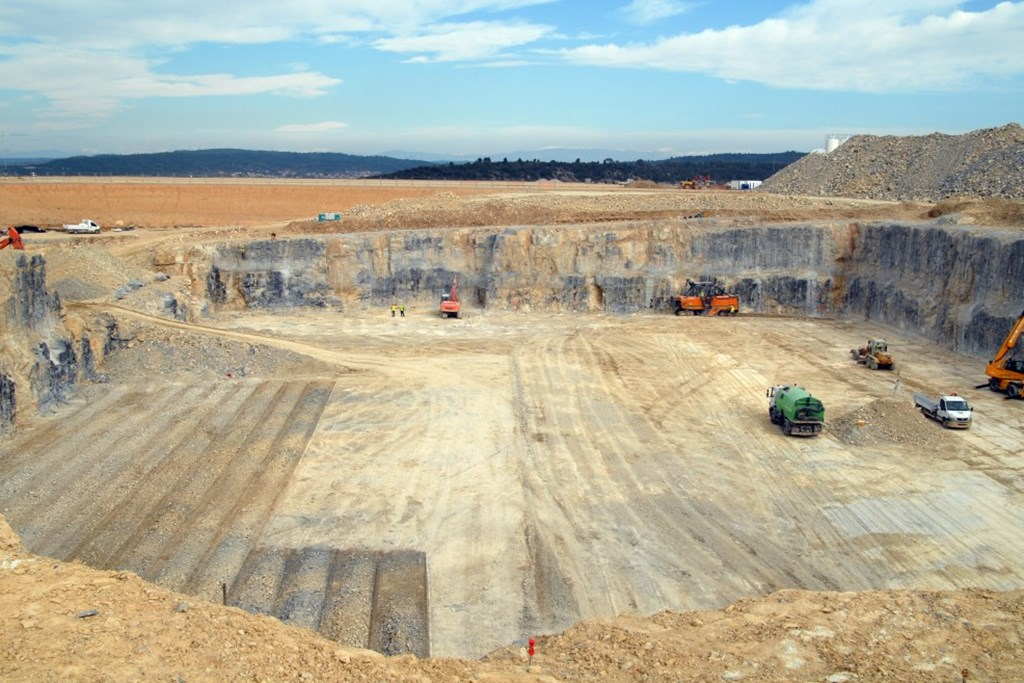
In 2011, the foundation was poured.

Below in the photo are active seismic supports. They are replaceable: if one of them fails, a special robot will climb under the building and replace it.

On top of the concrete slab there is a special anti-seismic layout of the reinforcement, which will be poured with concrete.
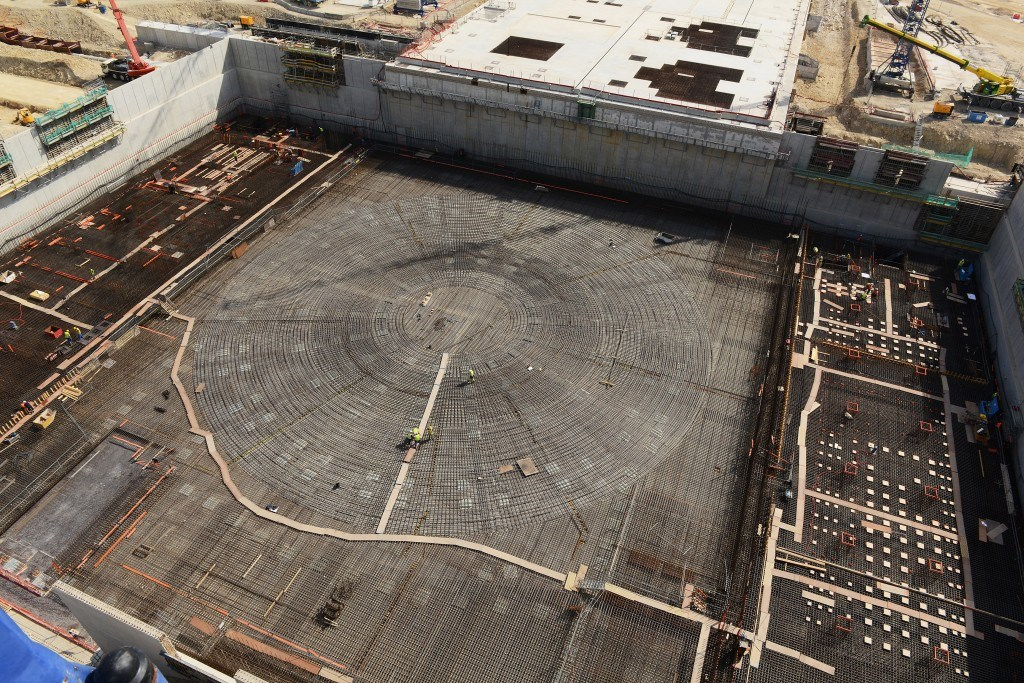
I came to the project in 2013. Then all the construction went underground and looked something like this:
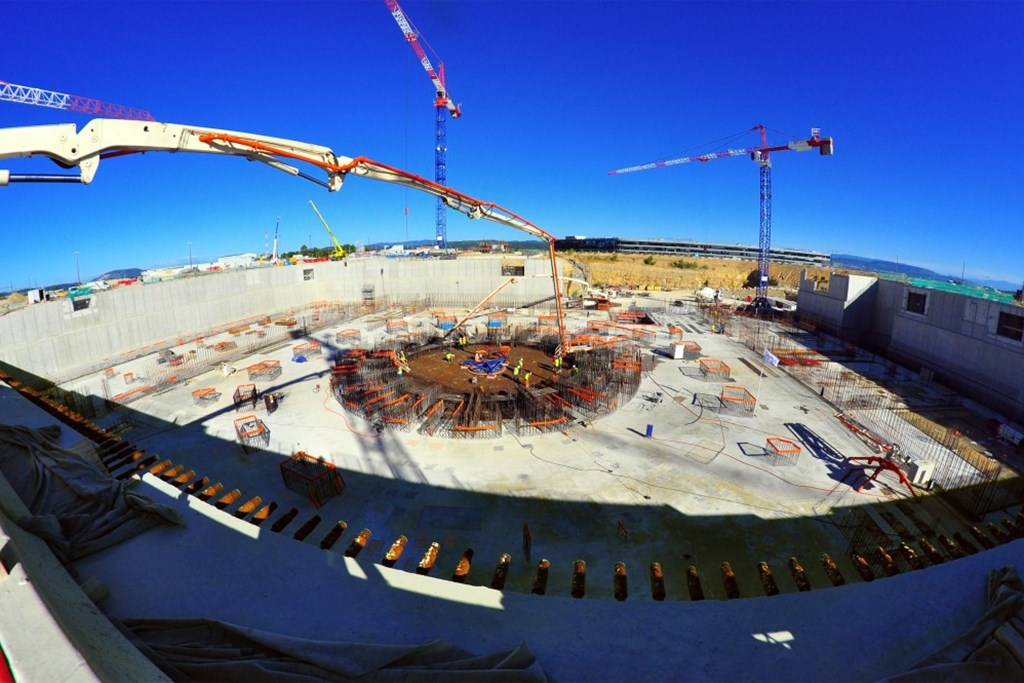
From the end of 2014, the construction of walls above the ground began. In the photo below - Assembly Building. All major components of the system will enter it for preliminary assembly, and they will be transferred to the tokamak building using a large crane.
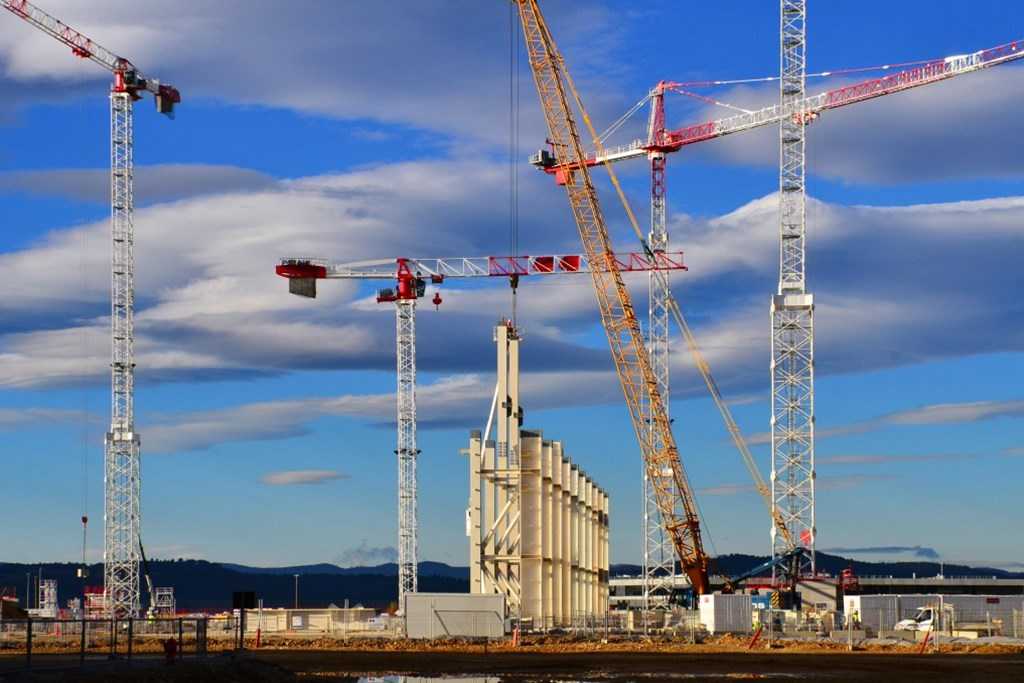

And this is a high voltage substation and transformers.
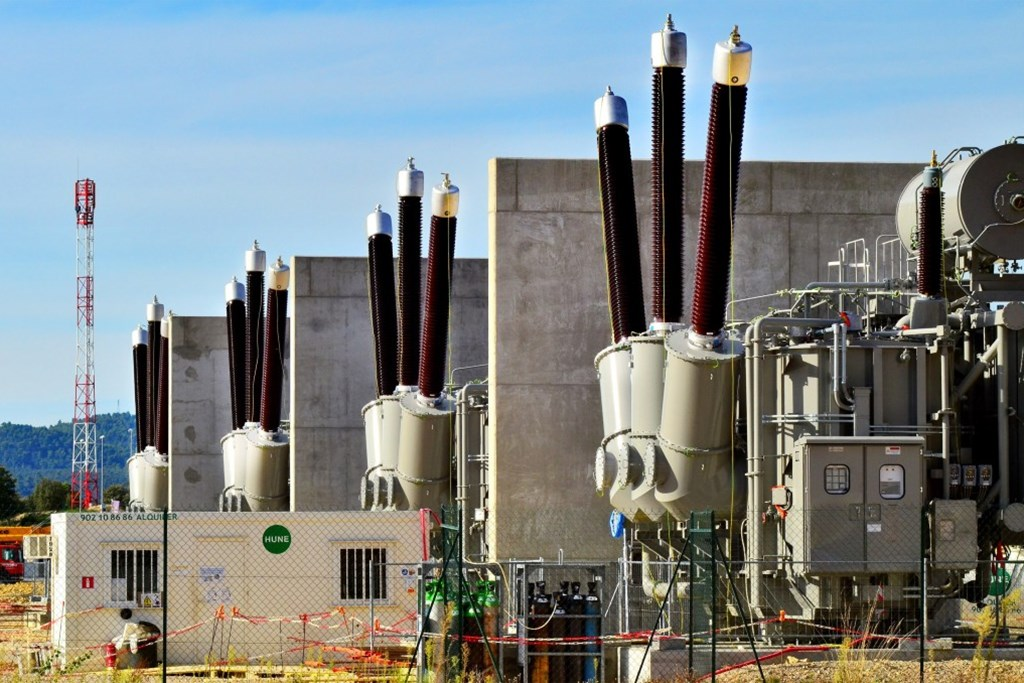
In 2015, the Assembly Building was wrapped in the outer walls.

And this is a photo of 2016:

And the photo below clearly shows the progress from 2014 to spring 2020. The photos were taken from different angles, but they show significant improvements.
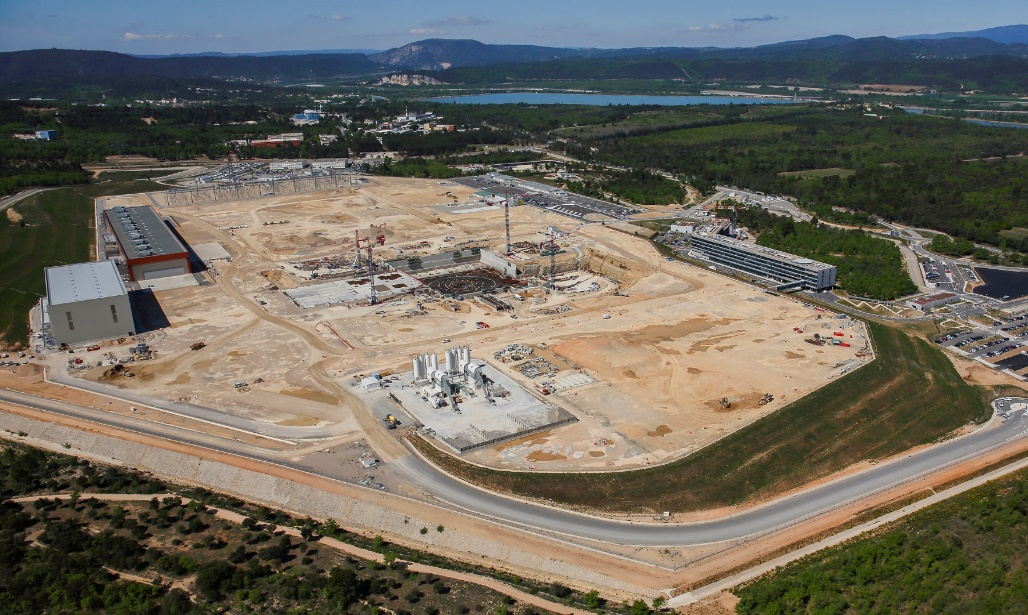
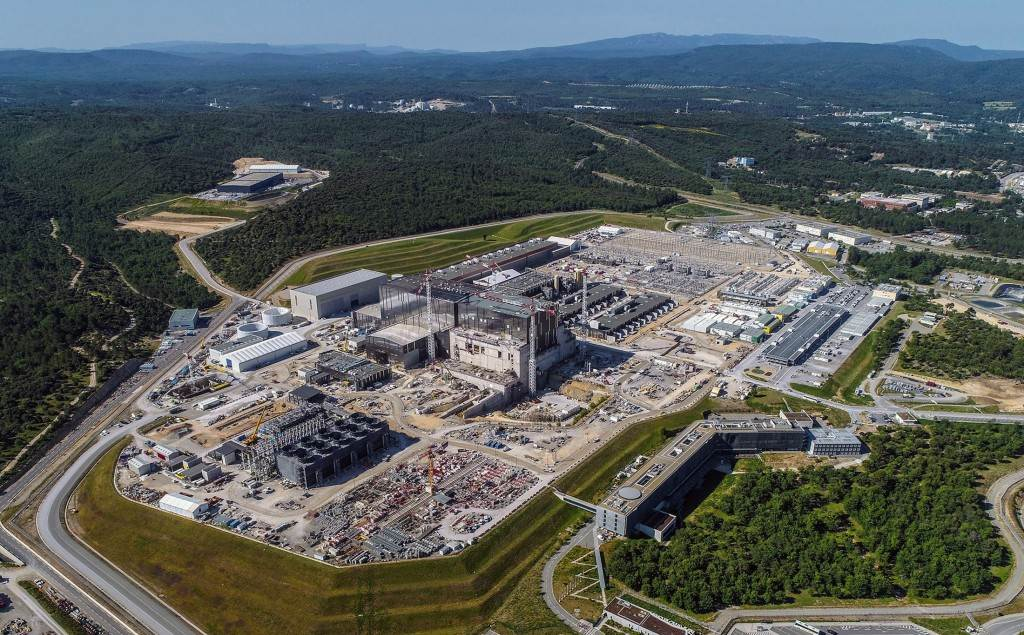
And this is how the project looks today:
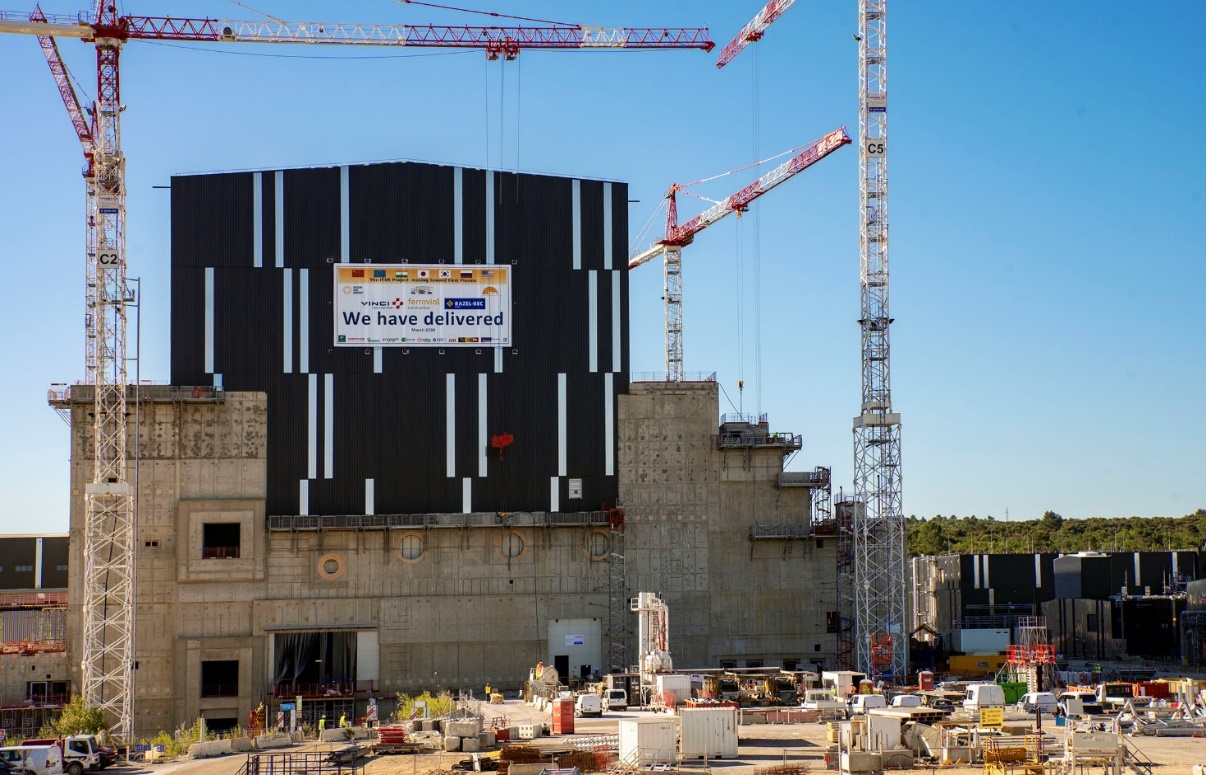
The concrete tokamak building with walls 1-1.5 m thick was completed on June 18, 2020 (the metal structure on top is temporary).
A few more photos of progress. The first shot was taken inside the tokamak building. The ITER tokamak will be located under this cover. In the distance you can see the assembly building and the moving crane.
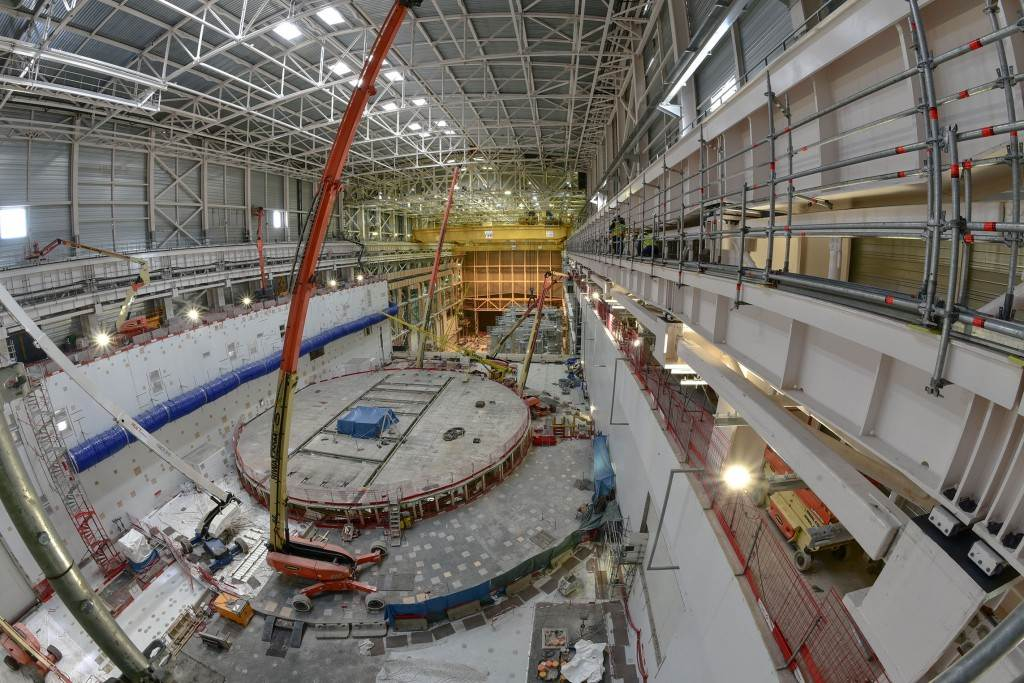
And this is the base of the cryostat. It has already been installed where the tokamak will be assembled.
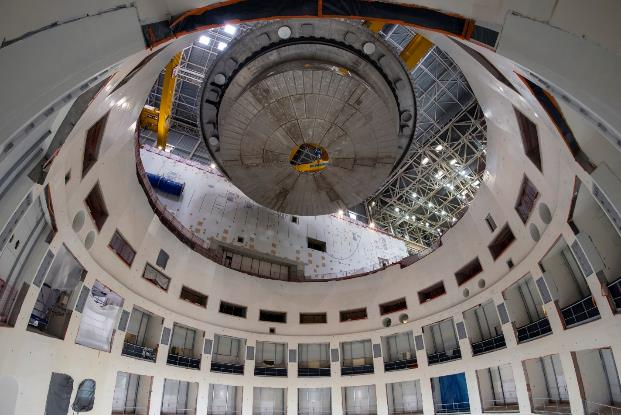
At the beginning of summer 2020, the ITER project officially moved from the construction stage to the assembly stage. We receive large tokamak elements at the construction site almost every week: coils, parts of a vacuum chamber. And this is a new challenge. Huge components have to be customized with the precision of the movement. For example, the tolerances for the manufacture of a vacuum chamber (a 30-meter structure weighing slightly less than a kiloton) is 1 mm. Equipment may need to be adjusted to fit inaccurate component dimensions.
And in parallel there is a constant refinement of the design, alteration of drawings.
For example, electricians have figured out that thicker wires should be used. Those, in turn, do not fit into the pipelines, plus you will have to increase the holes in the walls. This means that the outward neutron flux will increase. Bottom line: more radiation-resistant electronics will have to be developed.There is a joke that every two years the project is rebuilt. But at the same time, not a single step can be missed: you cannot do nothing for eight years, turning on only at the final stage. It is necessary to go all the way from start to finish.
Project structure
As I said, the project has seven participants. In accordance with the basic agreement, the European Union invests 45%, the rest of the countries 9% each. They invest money - in a central organization in the south of France. As well as equipment (installation parts) and the best minds.
The bar chart below shows how member countries are investing in individual areas.

The eighth abbreviation JF, apparently, hides the share of other countries (Kazakhstan and Australia). This distribution is fairly flat. The directions are not divided between countries, and this is a deliberate step so that knowledge in each of the areas is not concentrated in one hand. Everybody does a little. For example, Russia is responsible for the upper pipes of the vacuum chamber. She also makes several diagnostic systems.
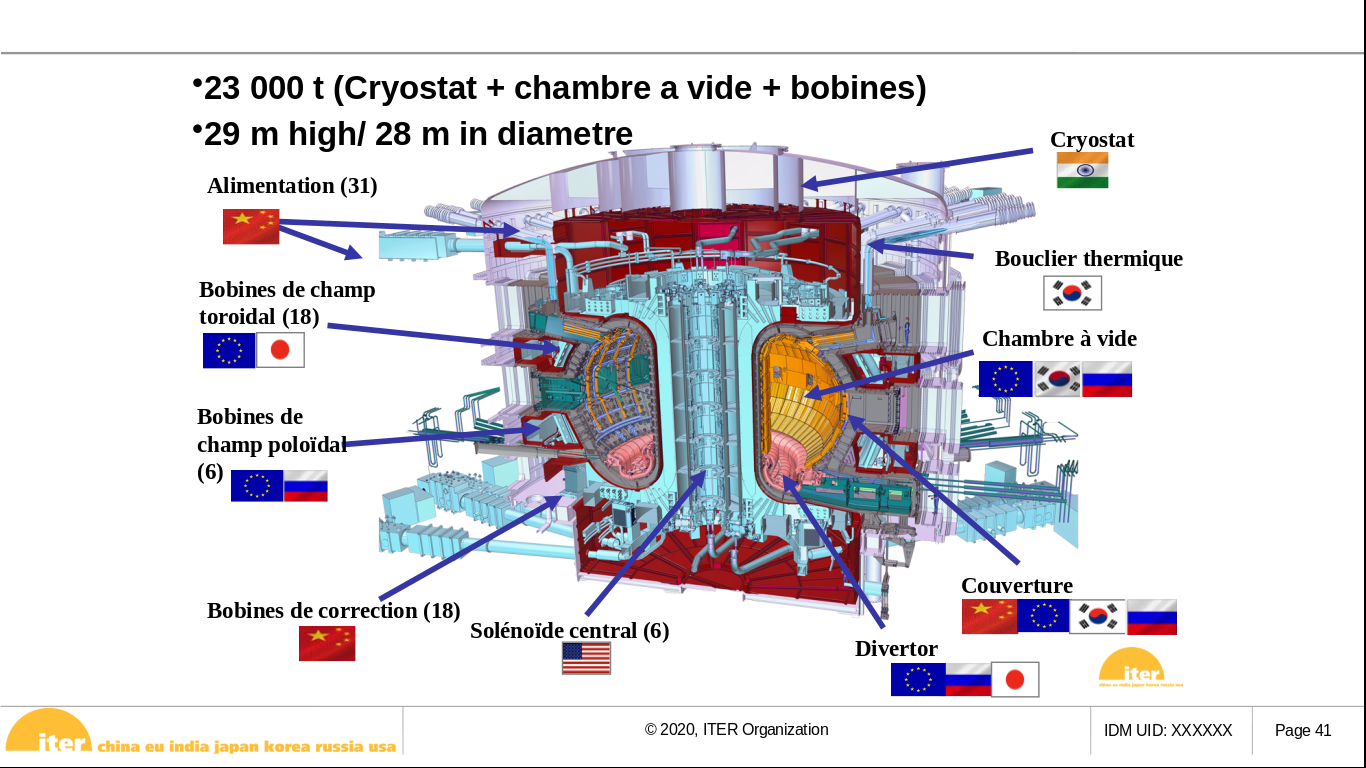
It can be seen here that Russia supplies coils of a toroidal field, part of divertors, several modules of thermal protection, part of a vacuum chamber.
An important point, which I would like to dwell on, is the organization of processes in ITER.

In the center of the structure is the General Director of the ITER Organization, above him is the ITER Council, which includes representatives of all partners participating in the project. The governments of the participating countries are shown in green on the diagram.
The board manages the entire process, dictating its decisions to the director. He, in turn, embodies them into reality, managing a number of departments. There are only three of them on the diagram, in reality there are much more of them.
Departments communicate with the local agencies of the participating countries (sometimes called home agencies), and they interact with laboratories and industry - they are the ones who build the components of the tokamak and supporting systems.
Some subsystems are manufactured by ITER directly, but most still go through the entire chain - from the director to the factory in a particular country.
As you can see from the diagram, there is no linear project management. Local agencies have access to their governments, and the chain is closed. This non-linearity is an important feature of ITER: different parties are involved in any issue.
There are four main stages defined for ITER.

Timeline of the project. Full capacity is scheduled for 2035. After that the system will be used only for scientific purposes and for testing technologies
The so-called Stage Approach Configuration should produce the first plasma by December 2025. This date was set several years ago, and it is not moving, despite the coronavirus and political changes.In this configuration, ITER will operate for only six months. We call this stage "political plasma": at low power, it will help us check the vacuum chamber, heating system, magnets. As a result, we must understand that the vacuum chamber is working and a plasma is being created.
Further, additional assembly of thin systems, including plasma heating systems, will begin. As assembly progresses, Prefusion power operations 1 and 2 are planned for 2028 and 2032, respectively.
The maximum capacity will be reached in December 2035. After 2035, ITER will operate for scientific purposes for another 10 years. 5.5 thousand discharges of 500 MW for 500 seconds are planned.
Instead of totals
At this stage, we are not talking about the commercial production of electricity by fusion. Neutrons will not be captured and their energy will not be converted to electricity. Neutrons will leave the installation and will be trapped by the building's concrete walls. Particles will penetrate rooms and cells, so there will be no people in the building during the installation. And the mechanical properties of materials subjected to constant neutron bombardment are, of course, calculated taking into account the planned lifetime of the facility (the total neutron yield over the entire operating time of the facility is about 10 21 ).
In theory, there are several ways to use the kinetic energy of neutrons for good. I already mentioned one - to heat the water and put the turbine on. The second way is hybrid. A small tokamak can be overlaid with uranium-238 and neutrons can be used to support the uranium decay reaction. In this case, the uranium mass can be much less than the critical one, i.e. explosion will not occur under any circumstances. If something goes wrong in such a hybrid setup, the reaction will simply die out. Uranium will work only due to the fact that it is bombarded by neutrons that appear when a thermonuclear reaction takes place. And although such a station produces radioactive waste, it is safe - it cannot explode.
But the final goal is, of course, pure fusion, with no uranium or nuclear waste. This is the only correct goal, but the path to it is long and difficult. If ITER fulfills its function and answers the question of whether it is possible to obtain 10 times more energy output than spent by 2035–2045, we will start building a demonstration station. In the best case, by 2050, she will answer whether the project will have a commercial start.However, it is necessary to move in this direction. And ITER is a great deal. Each participant contributes 9%, but receives 100% of the development. In fact, this is a large educational project for all countries, which costs much more than any commercial development. Despite this, the project is proceeding according to schedule and does not disappoint. Every year they trust him more and more, which means that further work should go better and faster.

The main construction phase of ITER has been completed. The time has come for assembling the reactor (photo - March 2020)
In general, this will be a gift to our grandchildren. How the project is progressing is described on the ITER Organization's YouTube channel .